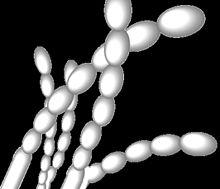Streptomyces griseus
| Streptomyces griseus | |
|---|---|
 |
|
| Spore arrangement in Streptomyces griseus. Grey spores arranged in straight chains, as is typical of these strains. | |
| Scientific classification | |
| Domain: | Bacteria |
| Phylum: | Actinobacteria |
| Order: | Actinomycetales |
| Family: | Streptomycetaceae |
| Genus: | Streptomyces |
| Species: | S. griseus |
| Binomial name | |
|
Streptomyces griseus (Krainsky 1914) Waksman and Henrici 1948 |
|
| Synonyms | |
|
Actinomyces griseus Krainsky 1914 |
|
Actinomyces griseus Krainsky 1914
Streptomyces griseus is a species of bacteria in the genus Streptomyces commonly found in soil. A few strains have been also reported from deep-sea sediments. It is a Gram positive bacterium with high GC content. Along with most other streptomycetes, S. griseus strains are well known producers of antibiotics and other such commercially significant secondary metabolites. These strains are known to be producers of 32 different structural types of bioactive compounds. Streptomycin, the first antibiotic ever reported from a bacterium comes from strains of S. griseus. Recently, the whole genome sequence of one of its strains had been completed.
The taxonomic history of S. griseus and its phylogenetically related strains has been turbulent. S. griseus was first described in 1914 by Krainsky, who called the species Actinomyces griseus. The name was changed in 1948 by Waksman and Henrici to S. griseus. The interest in these strains stems from their ability to produce streptomycin, a compound which demonstrated significant bactericidal activity against organisms such as Yersinia pestis (the causative agent of plague) and Mycobacterium tuberculosis (the causative agent of tuberculosis). Streptomycin was discovered in the laboratory of Selman Waksman, although his PhD student Albert Schatz probably did most of the work on these strains of bacteria and the antibiotic they produce.
...
Wikipedia
